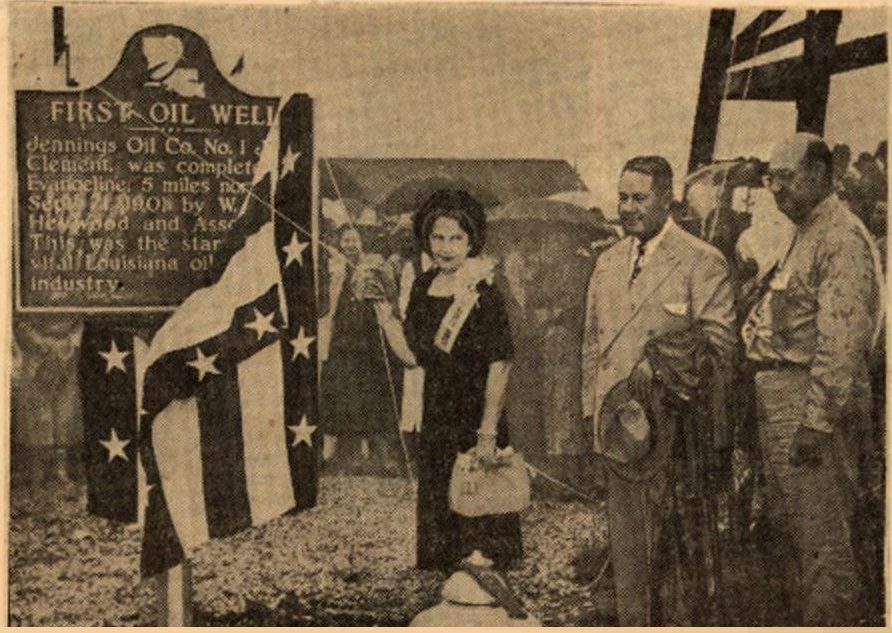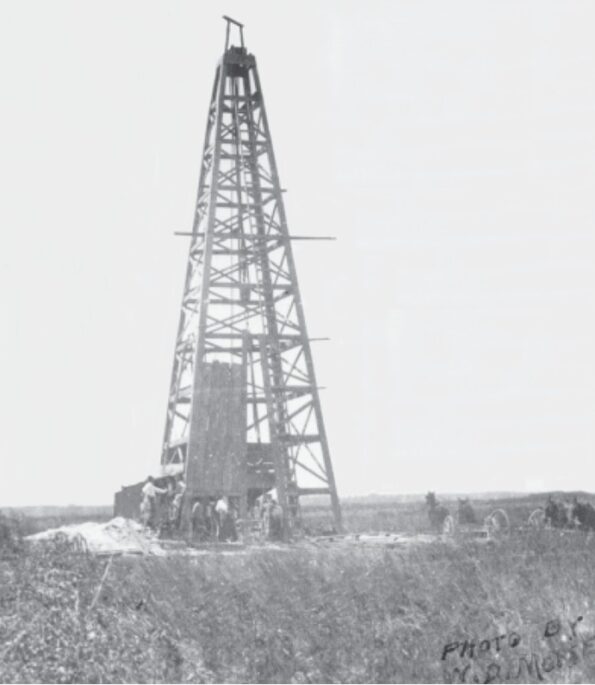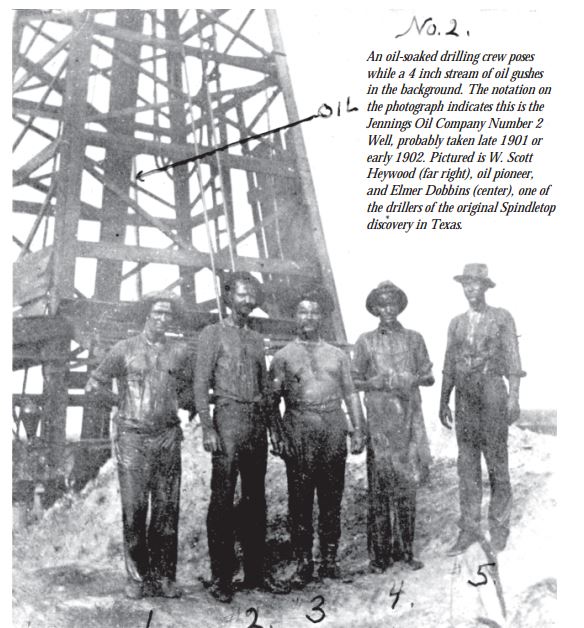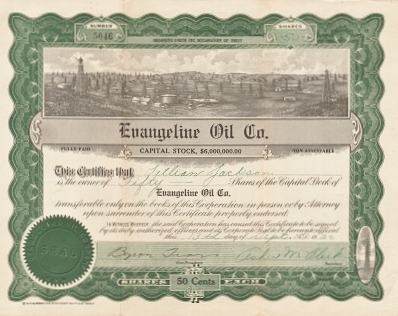First Louisiana Oil Wells
Acadia Parish oil seeps inspired 1901 Jennings oilfield discovery.
The first Louisiana oil well in 1901 revealed the giant Jennings field and launched the Pelican State’s petroleum industry. By 1911, offshore exploration included barges, floating pile drivers, and drilling platforms on Caddo Lake.
Nine months after the 1901 “Lucas Gusher” at Spindletop, Texas, oil erupted 90 miles to the east in Louisiana. W. Scott Heywood — already a successful wildcatter at Spindletop — drilled the discovery well of the Jennings oilfield. His September 21, 1901, gusher initially produced 7,000 barrels of oil a day.
Louisiana’s first commercial oil well was completed on the Jules Clements farm, about seven miles northeast of the small town of Jennings.

Mrs. Scott Heywood, “the widow of Louisiana’s oil discoverer, the late W. Scott Heywood,” unveiled a historical marker on September 23, 1951, as part of the Louisiana Golden Oil Jubilee. Times Picayune (New Orleans) image courtesy Calcasieu Parish Public Library.
Local investors earlier had formed the Jennings Oil Company and hired Scott, who recognized that natural gas seeps found nearby were nearly identical to the conditions observed at Spindletop.
Scott would insist on drilling deeper than many investors thought wise.

The Jennings Oil Company No. 1 well, which discovered the first commercial oilfield in Louisiana on September 21, 1901. Photo courtesy Louisiana Geological Survey.
“At the age 29, W. Scott Haywood was already a seasoned, experienced and successful explorer,” noted Scott Smiley, a Louisiana Geological Survey (LGS) historian. “He had gone to Alaska in 1897 during the great Yukon gold rush, sinking a shaft and mining a profitable gold deposit.”
Haywood, who also had drilled several successful oil wells in California, was one of the first to reach Spindletop following news of the January 1901, oilfield discovery. Haywood eventually convinced the reluctant Clements to allow drilling in the farmer’s Acadia Parish rice field. The Clements farm was at the small, unincorporated community of Evangeline, northeast of Jennings.

W. Scott Heywood discovered Louisiana’s Jennings field.
However, after drilling to 1,000 feet without finding oil or natural gas, the Jennings Oil Company’s investors wanted to abandon the first attempt.
“After all, 1,000 feet had been deep enough to discover the tremendous oil gushers at Spindletop field,” explained Smiley in a 2001 history of the Jennings field. “Instead of drilling two wells to a depth of 1,000 feet each, Heywood persuaded the investors to change the contract to accept a single well drilled to a depth of 1,500 feet.”
More drilling pipe was brought in and the well deepened.
Deeper Drilling Pays Off
Heywood found signs of oil at a depth of 1,700 feet – after some discouraged investors had sold their stock when drilling reached 1,000 feet. By 1,500 feet, shares of the Jennings Oil Company still sold for as little as 25 cents each. Patient investors were rewarded when 7,000 barrels of oil per day suddenly erupted from the well.
“The well flowed sand and oil for seven hours and covered Clement’s rice field with a lake of oil and sand, ruining several acres of rice,” reported the Jennings Daily News.

W. Scott Heywood (5) and Elmer Dobbins (3) — “one of the drillers of the original Spindletop discovery in Texas.” Photo courtesy Louisiana Geological Survey.
Although the Jules Clements No. 1 well is on only a 1/32 of an acre lease, it marked the state’s first oil production and launched the Louisiana petroleum industry. It opened the prolific Jennings field, which Heywood developed by securing leases and building pipelines and storage tanks.
The Jennings oilfield reached its peak production of more than nine million barrels in 1906. Meanwhile, an October 1905 discovery in northern Louisiana further expanded the state’s young petroleum industry (visit the Louisiana Oil Museum in aptly named Oil City).
Haywood returned to Alaska in 1908 on a big-game hunting trip. He retraced much of his travels to the Klondike gold fields, notes Smiley. “After a brief retirement in California, he returned to Jennings and drilled several wells at Jennings and elsewhere in Louisiana,” Smiley reports, adding the he also found success at the Borger and Panhandle oilfields in Texas.
“Heywood returned to Jennings in 1927 and assisted Gov. Huey P. Long in passing legislation to provide schoolbooks for children,” concluded the geologist in Jennings Field – The Birthplace of Louisiana’s Oil Industry, September 2001.

Rapid development of the Jennings oilfield in the early 1900s led to new conservation laws. A lack of spacing regulations forced “each leaseholder to drill their own well to prevent the draining of oil from the lease by an adjacent well.” Circa early 1900s photo courtesy Louisiana Geological Survey.
A retired professor challenged the date of Louisiana’s first commercial oil well during a 2011 presentation at Carnegie Library in Sulphur. Thomas Watson, PhD, “has uncovered evidence that the first producing oil well in Louisiana was at the Sulphur Mines in 1886,” noted the Sulphur Daily News.
“This information could alter the history of oil production in Louisiana,” Watson reported.
Offshore Caddo Lake
Gulf Refining Company in 1911 drilled Ferry Lake No. 1 on Caddo Lake, Louisiana, using a fleet of tugboats, barges, and floating pile drivers. When the first well produced 450 barrels of oil per day, Gulf constructed platforms every 600 feet on each 10-acre lakebed (see Offshore Drilling History).
Along with wells on a lake in Ohio, the Caddo Lake wells have been called the birth of America’s offshore drilling industry. Oil was produced from platforms on Grand Lake St. Marys as early as early as 1887 (see Ohio Offshore Wells).
_______________________
Recommended Reading: Louisiana’s Oil Heritage, Images of America (2012); Early Louisiana and Arkansas Oil: A Photographic History, 1901-1946
(1982). Your Amazon purchase benefits the American Oil & Gas Historical Society. As an Amazon Associate, AOGHS earns a commission from qualifying purchases.
_______________________
The American Oil & Gas Historical Society (AOGHS) preserves U.S. petroleum history. Please become an AOGHS annual supporter and help maintain this energy education website and expand historical research. For more information, contact bawells@aoghs.org. Copyright © 2024 Bruce A. Wells. All rights reserved.
Citation Information – Article Title: “First Louisiana Oil Well.” Authors: B.A. Wells and K.L. Wells. Website Name: American Oil & Gas Historical Society. URL: https://aoghs.org/petroleum-pioneers/first-louisiana-oil-well. Last Updated: September 14, 2024. Original Published Date: September 1, 2005.



 As is often the case, several petroleum companies have shared popular names, and this is the case with Evangeline Oil Company.
As is often the case, several petroleum companies have shared popular names, and this is the case with Evangeline Oil Company.